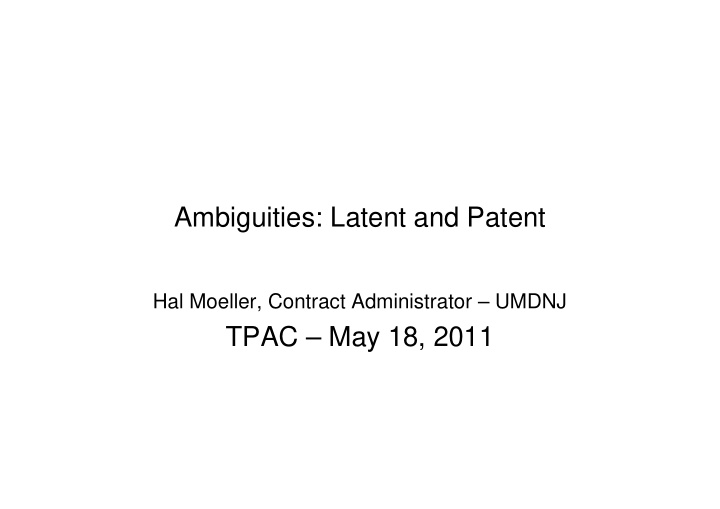



Ambiguities: Latent and Patent Hal Moeller, Contract Administrator – UMDNJ TPAC – May 18, 2011
Ambiguities • Discrepancies in specifications • Omissions • Significant conflicts within the specifications
Ambiguities = Unexpected Costs • Resolution of ambiguities adds costs to the performance of the contract. • Correcting the discrepancy adds to the cost of the contract.
States Roofing v. Navy • Ambiguity involved language in the specifications for roof repair on a large warehouse on a Navy base. • Firm fixed price contract awarded in a competitive process following an on-site pre-bid conference
Roof Repair • Repair work involved eleven cells, each with a penthouse on top of the main roof of the building. • Each penthouse has a vertical element called parapet walls.
Roof Repair • Contract called for each parapet wall to be waterproofed. • Dispute centered around the material used for the waterproofing.
Contract Specifications • Waterproofing on the parapet walls was to include 3 coats, layers or plies of waterproofing material. • States developed its bid and interpreted the contract to permit applying waterproofing paint. • The Navy, once the contract was underway, interpreted and required use of 3-ply felt flashing.
Contract Performance • States complied with Navy’s request and finished the contract using flashing, not paint, and sought an equitable adjustment afterwards
Patent Ambiguity • Navy argued the ambiguity was patent and States had a duty to inquire whether its intended use of waterproofing paint was acceptable. • Patent ambiguity is one that is gross, obvious, glaring so that contractor has a duty to inquire about it upon learning of the uncertainty.
Latent Ambiguity • An ambiguity not so glaring as to be patent is considered latent. • The rule of contra proferentem applies – Ambiguity in contracts drafted by the government will be construed against the drafter.
Ethical Imperative WPC Enterprises v U.S. Ct. Cl. 1963 If some substantive provision of a government drawn contract is fairly susceptible of a certain construction and the contractor actually and reasonably so construes it, that is the interpretation which will be adopted, unless the parties’ intention is otherwise affirmatively revealed. If the government chafes under the continued application of this check, it can obtain a looser rein by a more meticulous writing of its contracts and especially of the specifications.
Ethical Imperative • Bidders must not be encouraged to submit low bids for work that they know to be ambiguous in the expectation that they will seek change orders and be granted increases - - to be rewarded for their duplicity. • If the ambiguity is patently obvious to the bidder, the bidder has a duty to inquire and if it does not inquire, the contractor is left with the result.
Recommend
More recommend